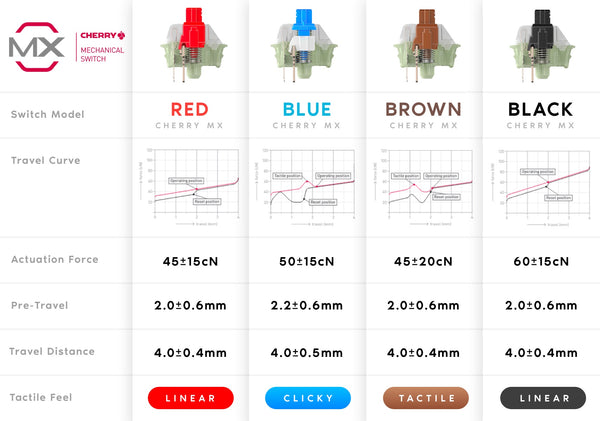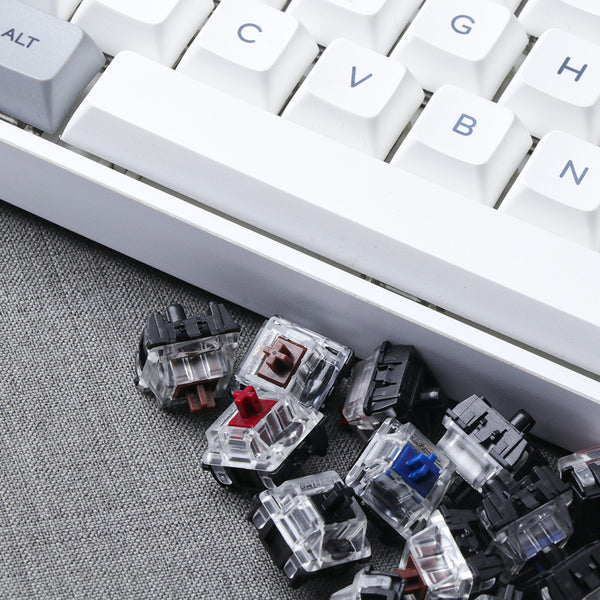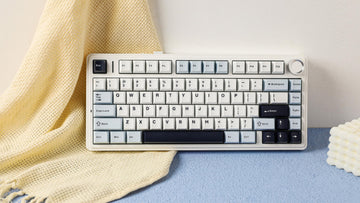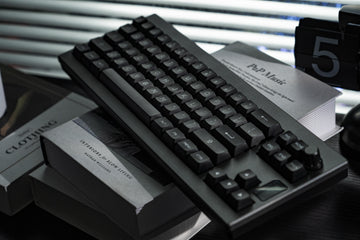
Before choosing what type of mechanical or optical switch, we need to understand it is mostly about preference. You need to look into what will work best for you and what you will use your keyboard for the most. Our Epomaker GK series, and some of our other keyboards allow for hotswappability. This means that even if you dislike the current switch you bought, you can swap it to another switch. Which switch you can swap to depends on your keyboard type.
While looking for switch types, you may find there are many different lingoes and names for each switch. To help you cut through all the confusions and explain in simple terms, we can break down the different behaviour of switches into three categories: linear, tactile and clicky.
Linear Switches VS Tactile Switches VS Clicky Switches

Linear Switches
Linear switches are smooth and consistent when pressed down. They usually make less noise in comparison to their tactile and clicky counterparts. The switch is fast, which makes it fantastic for gaming.
Tactile Switches
Tactile switches consist of a bump in the middle, which often occurs in the middle of the press. This switch is a middle ground for typing and gaming. It gives enough feedback to “feel” when a key is pressed, but not requiring to go through a “click” such as a clicky switch.
Clicky Switches
The clicky switch has a bump in the middle, but it is followed by a clicking noise. This clicking noise depends on a switch-by-switch basis. Due to the click, it is great for typing - giving clear feedback when the key is pressed. It can, however, be a bit harder to game on as it requires for you to go through this feedback, so quick presses might feel less responsive.
Find The Ideal Switches For Your Keyboard
If you ask anyone, different switches will have their preferences on what type of switch they prefer and why. This great thing is that between those switches there are many different variants and brands to choose from. At Epomaker, we sell a few types of switches:
Mechanical Switches
- Cherry MX Switches
- Gateron Mechaincal Switches
Optical Switches
- Gateron Optical Switches
Other Custom Switches
- Electro Capacitive Switches
- Brand Custom Switches (Ajazz FirstBlood Switches, AKKO switches, etc.)
Mechanical Switches
Mechanical switches use electrical components and pins. They actuate through electrical contact. Many people prefer the sound and feel of a mechanical switch, and often say that they are smoother than their optical counterparts. The technology of mechanical switches is much more mature - there are hundreds, if not thousands of variants of switches to choose from as there is a standard for them. While optical switches do not really have a standard currently.
Optical Switches
Optical switches use light to actuate, and do not use pins like mechanical. There are quite a few benefits from removing electrical contact: The switches make the keyboard water-resistant, unlike mechanical switches. They actuate faster, therefore making them greater for gaming. The Gateron Optical Mechanical switches offer a 100 million keystroke lifespan, while Gateron Mechanical switches offer 50 million keystrokes. Our keyboards work with industry-leading Gateron Opticals, allowing for hotswappability with the Gateron Switch line.
Electro Capacitive Switches
Electro capacitive switches consist of a rubber dome over a coiled spring. This allows for the keyboard to have a unique tactile bump and light feedback to the switch. It feels like a mechanical switch, but with the softness of a rubber dome. This allows for a very quiet typing experience which is perfect for something like an office environment.
Staff Pick: Epomaker NiZ Plum Atom 66/68/84
Brand Custom Switches
Companies can also collaborate with the factories to custom switches according to their needs. Generally, these custom switches either use electrical components and pins or use light to actuate, and they can be replaced with mechanical switches or optical switches accordingly (if the keyboard is hot swappable). Thus, you may also see them as a type of mechanical/optical switches. An example is the Ajazz K620T Upgrade 2.0 which uses the Ajazz Firstblood Switches. Its switches can be replaced with 3 pin mechanical switches, such as Cherry MX mechanical switches and Gateron Mechanical switches.
Cherry and Gateron, what should I choose?
One other thing to consider is the brand. At Epomaker, we offer Gateron and Cherry for our GK series, and sometimes we also have exclusive ones (Such as our Ajazz Firstblood Switch). We will however show the ones we offer for hotswappability here so you know what the best switch is for you.
Cherry Mechanical Switches
Cherry MX switches are produced in Germany and were the original company to patent the MX style housing. Cherry is more expensive than Gateron, but has often been described as being more reliable and is put into higher-end boards. Cherry switches are put through significant stress tests and have been researched into heavily when it comes to their switch design. The most common seen Cherry switches are Cherry MX Red, Blue, Brown, and Black. You may also find some other Cherry switches in the market such as Cherry Silent series, Cherry MX low profile switches, so on and forth.
Staff Pick: Cherry MX Switch Set
Cherry MX Red
The Cherry MX Red is a linear switch, designed to be smooth, light and quiet, it has an actuation force of 45 grams and a bottom out force of 75 grams. The switches are great for gaming due to their responsiveness.
Cherry MX Black
Cherry MX Black is similar to Reds but has a heavier actuation force. It is a linear switch that is smooth but heavy. The switches have an actuation force of 60 grams and a bottom out force of 85 grams. They are great for gaming and also typing.
Cherry MX Brown
Cherry MX Browns are a tactile switch, they have a bump and have a moderately loud noise. They have an actuation force of 55 grams and a bottom out force of 60 grams. The switch is great for both typing and gaming, and could be used in an office environment if the sound isn’t too much of a concern. They are louder than Cherry MX Reds or Blacks.
Cherry MX Blue:
Cherry MX Blues are a clicky switch, which means that there is a clicking noise and a bump on every press. They have an actuation force of 60 grams and also the same bottom out force. They do offer a great experience if you are typing for long periods of time due to their responsiveness. However, they are often classed as the loud switch, so they are not good for environments where noise is of concern.
If you want to go a bit deeper and look into the specification, we prepare a clean and clear table for you:

Gateron Mechanical Switches
Gateron switches are a budget-friendly option when it comes to switches, with very high value for what they offer. They are smoother than the Cherry MXs series, but are only designed to last 50 million keystrokes in comparison to the 100 million keystrokes set out by the Cherry MX line. Similar to the Cherry switches, the common seen Gateron Mechanical switches are Gateron Red, Blue, Black, and Brown. We at Epomaker also have some new types of Gateron Mechanical switches, such as Gateron Mechanical Yellow switches, Gateron Mechanical Silver Switches, Gateron Green Mechanical Switches, and Gateron Mechanical White Switches, which we will introduce in another post.
Staff Pick: Gateron Mechanical Switch Set
Gateron Mechanical Reds:
Gateron Reds are also a linear switch and have an actuation force of 45 grams, same as the Cherry MX Reds. They are quiet and great for gaming and office use. They allow for keystrokes to register quickly due to their low actuation force, which makes them great for competitive gaming.
Gateron Mechanical Black:
Gateron Blacks are the heaviest common offering when it comes to the Gateron standard switch line. They have an actuation force of 60 grams. However, they have a heavier bottoming out force, contributing towards making them harder to actuate. They are great for those that do not want to accidentally press their switch and can help towards improving accuracy when typing.
Gateron Mechanical Brown:
Gateron Browns have a more pronounced bump than the Cherry counterpart. It has a tactile bump with a 55-gram actuation force. It is great for those that want to have a tactile bump without the loudness of a click from a clicky switch like the Gateron Blue, making them great for both gaming and typing.
Gateron Mechanical Blue:
Gateron Blues have an actuation force of 55 grams. They have both the bump and click that is standard on every switch. It is great for typists, but can be considered quite loud and shouldn’t be used in environments where noise is an issue. Gateron Blues have a much sharper, louder click when it compares to Cherry MX Blues.
Also, we prepare another table to conclude the specification for Gateron Mechanical switches:

Gateron Optical Switches
Optical switches offer a 100 million keystroke long life span, and they are great for gaming. They are also more affordable than Cherry switches. However, since the optical switches use light to actuate and don’t have pins at the bottom, they can only be swapped with other optical switches. For example, if you have a keyboard that originally comes with optical switches, you can’t replace it with those mechanical switches with pins.
A question is asked frequently: what is the difference between Gateron Mechanical switches and Gateron Mechanical switches? Well, the answer can be shortened into three sentences.
- Keystroke life span: optical switch is longer than Gateron mechanical switch.
- Pins: optical switch doesn’t have pins, while Gateron mechanical switch has.
- Response rate: optical switch generally generates a faster response compared to the Gateron mechanical switch.
Staff Pick: Gateron Optical Switch Set
Gateron Optical Red:
Gateron Optical Reds have a 45gf actuation force. They are quiet in use, providing a linear feel. They are also popular with gamers, since they offer rapid execution key presses. If you play FPS games like Fortnite, you might like it.
Gateron Optical Blue:
Gateron Optical Blues generate a loud clicking sound and tactile bump when they are pressed. Similar to the Gateron Mechanical blues, the optical blues have a 55gf actuation force. It’s also good for typing and coding, but its sound could be a bit annoying if you use it in a small room with your colleagues.
Gateron Optical Brown:
Gateron Optical Browns have a 45gf actuation force, and it’s usually seen as a hybrid between clicky and linear switches. Compared with the Gateron Mechanical switches, it produces a quicker response, and it won’t make too much noise as what the optical blues do. It presents the bump still, making it perfect for those who want a quick response with a tactile feel but don’t want to bother peers around.
Gateron Optical Black:
Gateron Optical Blacks have a 60gf actuation force. They require more force to execute, which means you need to press harder compared with using the other three types of Gateron optical switches. Meanwhile, the Gateron Optical Black switches bring a linear feel with a quicker response compared with the Gateron Mechanical Blacks.
Here is the Gateron Optical switches specification table to help you have a quick look-up:

Custom Switches
Ajazz Firstblood Switches
Ajazz Firstblood Switch is a type of custom mechanical switch. Similar to Cherry MX switch and Gateron Mechanical switch, it also has electrical components and 3 pins, and actuates through electrical contact. On our website, we provide both clicky blue switches and linear pink switches for you, and you can choose according to your preference.
Staff Pick: Ajazz K620T Upgrade 2.0
Conclusion:
To conclude, the switch that you choose is all up to your preferences. Often, people go for either a Tactile or Linear switch because they have more options when it comes to modding and lubing the switches, and they are much more responsive for gaming. The good thing about our GK series is that it allows for hotswappability, so even if you dislike the switch you can always decide to swap it for something else!













